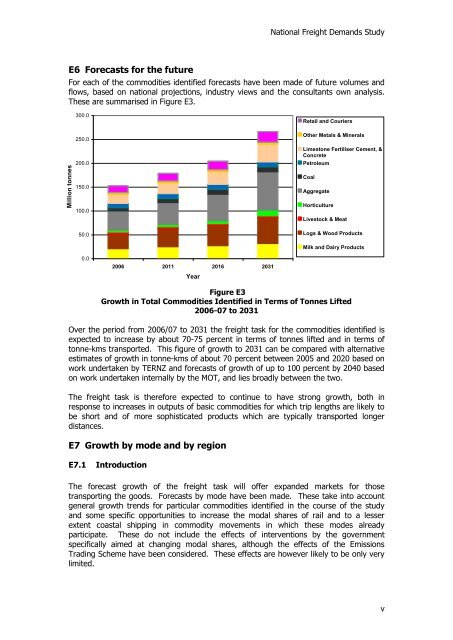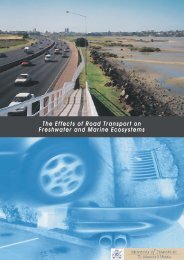- Page 1 and 2: NATIONAL FREIGHT DEMANDS STUDY SEPT
- Page 3 and 4: National Freight Demands Study TABL
- Page 5 and 6: National Freight Demands Study 3.14
- Page 7 and 8: National Freight Demands Study 9.5.
- Page 9 and 10: National Freight Demands Study E2 T
- Page 11: National Freight Demands Study Tabl
- Page 15 and 16: National Freight Demands Study For
- Page 17 and 18: National Freight Demands Study 1 In
- Page 19 and 20: National Freight Demands Study Road
- Page 21 and 22: National Freight Demands Study Most
- Page 23 and 24: National Freight Demands Study 2 Ap
- Page 25 and 26: National Freight Demands Study 2.4
- Page 27 and 28: National Freight Demands Study 3 Pr
- Page 29 and 30: National Freight Demands Study Some
- Page 31 and 32: National Freight Demands Study Milk
- Page 33 and 34: Million litres National Freight Dem
- Page 35 and 36: National Freight Demands Study 3.4
- Page 37 and 38: National Freight Demands Study 3.5
- Page 39 and 40: National Freight Demands Study Beca
- Page 41 and 42: National Freight Demands Study Sour
- Page 43 and 44: National Freight Demands Study 3.5.
- Page 45 and 46: National Freight Demands Study The
- Page 47 and 48: National Freight Demands Study Timb
- Page 49 and 50: Origin National Freight Demands Stu
- Page 51 and 52: National Freight Demands Study Boar
- Page 53 and 54: Origin National Freight Demands Stu
- Page 55 and 56: National Freight Demands Study The
- Page 57 and 58: Origin National Freight Demands Stu
- Page 59 and 60: National Freight Demands Study Tabl
- Page 61 and 62: National Freight Demands Study Tabl
- Page 63 and 64:
National Freight Demands Study Shee
- Page 65 and 66:
National Freight Demands Study 3.7.
- Page 67 and 68:
Origin National Freight Demands Stu
- Page 69 and 70:
National Freight Demands Study 3.8
- Page 71 and 72:
Regional council Potatoes Peas & be
- Page 73 and 74:
National Freight Demands Study Tabl
- Page 75 and 76:
Origin National Freight Demands Stu
- Page 77 and 78:
National Freight Demands Study Tabl
- Page 79 and 80:
National Freight Demands Study 3.9.
- Page 81 and 82:
Origin National Freight Demands Stu
- Page 83 and 84:
National Freight Demands Study 3.10
- Page 85 and 86:
National Freight Demands Study 3.10
- Page 87 and 88:
National Freight Demands Study 3.11
- Page 89 and 90:
National Freight Demands Study Port
- Page 91 and 92:
National Freight Demands Study From
- Page 93 and 94:
National Freight Demands Study Tabl
- Page 95 and 96:
National Freight Demands Study 3.13
- Page 97 and 98:
National Freight Demands Study On t
- Page 99 and 100:
National Freight Demands Study Tabl
- Page 101 and 102:
National Freight Demands Study Expo
- Page 103 and 104:
National Freight Demands Study From
- Page 105 and 106:
National Freight Demands Study 3.14
- Page 107 and 108:
National Freight Demands Study From
- Page 109 and 110:
National Freight Demands Study Anal
- Page 111 and 112:
Origin National Freight Demands Stu
- Page 113 and 114:
National Freight Demands Study 3.15
- Page 115 and 116:
Origin National Freight Demands Stu
- Page 117 and 118:
Origin National Freight Demands Stu
- Page 119 and 120:
National Freight Demands Study 3.16
- Page 121 and 122:
Origin National Freight Demands Stu
- Page 123 and 124:
National Freight Demands Study 3.17
- Page 125 and 126:
National Freight Demands Study Tonn
- Page 127 and 128:
Origin National Freight Demands Stu
- Page 129 and 130:
National Freight Demands Study For
- Page 131 and 132:
National Freight Demands Study The
- Page 133 and 134:
Origin National Freight Demands Stu
- Page 135 and 136:
Origin National Freight Demands Stu
- Page 137 and 138:
Origin National Freight Demands Stu
- Page 139 and 140:
National Freight Demands Study 4.7
- Page 141 and 142:
National Freight Demands Study 4.7.
- Page 143 and 144:
Origin National Freight Demands Stu
- Page 145 and 146:
National Freight Demands Study 5 In
- Page 147 and 148:
National Freight Demands Study Sour
- Page 149 and 150:
National Freight Demands Study Sour
- Page 151 and 152:
National Freight Demands Study Sign
- Page 153 and 154:
National Freight Demands Study Sour
- Page 155 and 156:
National Freight Demands Study The
- Page 157 and 158:
National Freight Demands Study 5.3
- Page 159 and 160:
National Freight Demands Study Figu
- Page 161 and 162:
National Freight Demands Study Deve
- Page 163 and 164:
National Freight Demands Study Much
- Page 165 and 166:
National Freight Demands Study 5.4
- Page 167 and 168:
National Freight Demands Study Impo
- Page 169 and 170:
National Freight Demands Study The
- Page 171 and 172:
National Freight Demands Study Grow
- Page 173 and 174:
National Freight Demands Study One
- Page 175 and 176:
National Freight Demands Study Land
- Page 177 and 178:
National Freight Demands Study Tabl
- Page 179 and 180:
Origin National Freight Demands Stu
- Page 181 and 182:
National Freight Demands Study 5.5.
- Page 183 and 184:
National Freight Demands Study The
- Page 185 and 186:
National Freight Demands Study 6 Ot
- Page 187 and 188:
National Freight Demands Study If t
- Page 189 and 190:
National Freight Demands Study 7 Tr
- Page 191 and 192:
National Freight Demands Study The
- Page 193 and 194:
National Freight Demands Study The
- Page 195 and 196:
National Freight Demands Study 8 Dr
- Page 197 and 198:
National Freight Demands Study In c
- Page 199 and 200:
National Freight Demands Study Tabl
- Page 201 and 202:
National Freight Demands Study 8.4
- Page 203 and 204:
National Freight Demands Study Anal
- Page 205 and 206:
National Freight Demands Study 9.4
- Page 207 and 208:
National Freight Demands Study In t
- Page 209 and 210:
National Freight Demands Study 9.6.
- Page 211 and 212:
Volume (000 tonnes pa) National Fre
- Page 213 and 214:
National Freight Demands Study Disc
- Page 215 and 216:
National Freight Demands Study Sour
- Page 217 and 218:
National Freight Demands Study Othe
- Page 219 and 220:
National Freight Demands Study 9.14
- Page 221 and 222:
National Freight Demands Study Tabl
- Page 223 and 224:
Million tonnes National Freight Dem
- Page 225 and 226:
Origin National Freight Demands Stu
- Page 227 and 228:
Origin National Freight Demands Stu
- Page 229 and 230:
National Freight Demands Study 9.20
- Page 231 and 232:
Total Flows Originiating in Region
- Page 233 and 234:
National Freight Demands Study 10 F
- Page 235 and 236:
National Freight Demands Study Anne
- Page 237 and 238:
National Freight Demands Study 221
- Page 239 and 240:
National Freight Demands Study Airp
- Page 241 and 242:
National Freight Demands Study Orga
- Page 243 and 244:
National Freight Demands Study Appe
- Page 245 and 246:
National Freight Demands Study Deta
















